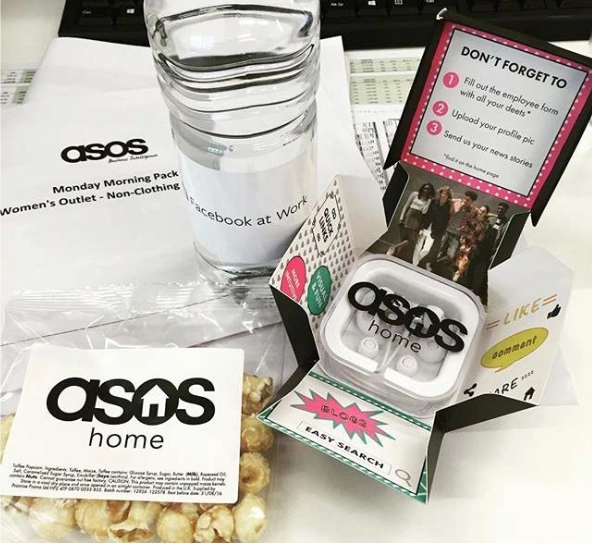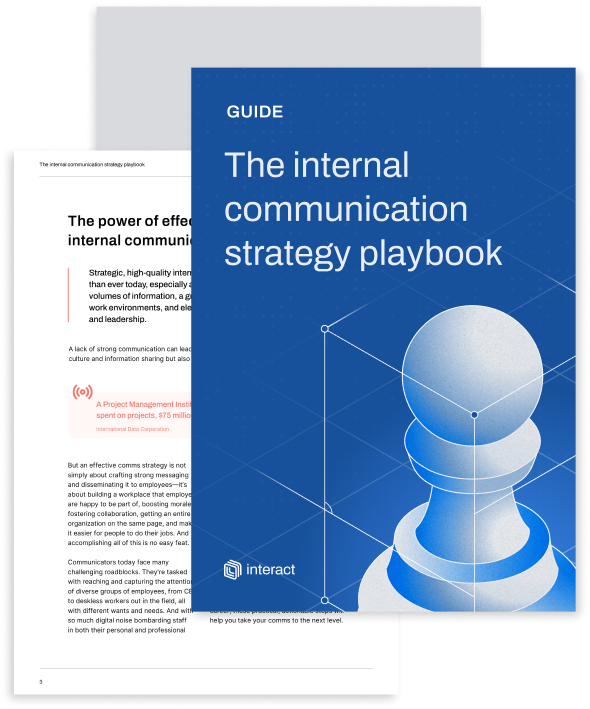Capturing and retaining employee attention is not easy. If you have important messages to get out or a key announcement to share, you’ll need a high-quality internal communications campaign that resonates with and engages your audiences. This article shows you how to create one in ten easy steps.
Internal communicators have got a lot of things to share: from impending business changes to company events, or even the launch of a new intranet. Those messages are competing with many others in a crowded digital landscape, however, so cutting through the noise and reaching your audience is hard.
Through a blend of strategy and technology, the best internal communications campaigns can command attention and drive employees to take relevant actions.
Here are ten simple steps to developing and deploying a winning internal communications campaign.
1. Set a clear objective for your internal communications campaign
A successful internal communications campaign has a clear goal.
Before you jump into creating campaign materials, set out precisely what you’re trying to achieve. Are you looking to inform employees of an upcoming change, or trigger them to complete a specific action? An internal communications campaign about an open enrollment announcement will look very different from one publicizing your company’s annual fundraiser.
Have you been tasked with communicating a merger or acquisition, or perhaps boosting interest in a new lunch-and-learn series? These goals will all require different campaign approaches.

Whatever the brief, try to define the outcome you’re looking for as specifically as possible, including any metrics for success. Beginning with concrete objectives will ensure your campaign is focused and delivers the desired results.
Free guide: Essential internal communications strategy
2. Identify and define your audience
Who are you targeting with your messaging?
Even if you’re tasked with communicating on an organization-wide level, your audience is made up of individuals who may not respond to a one-size-fits-all approach. This will impact how you design and execute your campaign.
Lay out who needs to receive the message you need to communicate. Then, break down their preferences, needs, and pain points. Consider their demographics, such as age, location, role, and digital fluency. What motivates them and what frustrates them? How do they like to receive information, and what content or messages do they tend to engage with more frequently?
To really understand your audience, we recommend creating employee personas, which serve as representations of the people you’re attempting to connect with. Personas will help you develop a better idea of who your users are and what types of strategies are helpful in communicating with them.
Defining audience personas and being clear about who you’re targeting will enable you to craft a tailored, empathetic message. This, in turn, will improve employees’ responses and engagement with your messaging, making your internal communications campaign more effective.
3. Figure out the “WIIFM” factor for your audience
The importance of your campaign’s messaging may be obvious to you, but it’s not a given that your audience sees it in the same way. Now that you know exactly what you’re trying to say, and who you’re trying to say it to, it’s time to answer another question, this time from the perspective of employees: “What’s in it for me?”
This means stepping into your audience’s shoes and understanding what the impact of your announcement is on an individual level. People care about things that impact them personally and often. For example, frontline staff may not care that an acquisition will boost company revenue and profitability. They will, on the other hand, be interested in hearing about job security, process changes, and disruption in their day-to-day roles.
This is where an employee-centric approach can work in your favor. For every piece of information you’re including in your campaign, make sure you’re asking yourself questions like:
- What does this mean for employees in various roles?
- Does this create any big changes in the ways employees do their jobs?
- How will employees benefit from the information shared?
- What questions will employees have on the topic and how can you make sure to answer them before they’re asked?
When you’re crafting communications collateral for your campaign, make sure to focus on the items employees will be most interested in. It may be helpful to break out those employee personas you created in Step 2, as different subsets of employees will be concerned with different aspects of your messaging.
Free guide: Essential internal communications strategy
4. Map out the channels for your internal communications campaign
We have a diverse range of communication tools at our disposal in the workplace: whether that’s Slack and Teams channels, SMS, an employee communication app, the company intranet, virtual all-hands meetings, digital signage, email, or even traditional posters by the watercooler.

Not every medium will be appropriate for every campaign, so you’ll need to find the best internal communication channels for your message and audience.
This is another step where audience research is key. How do different groups of employees tend to consume their content? If you’re targeting a large number of deskless workers, digital signage or updates via an employee mobile app could be the way to go. If you have a hybrid audience, you’ll want to consider a balance of in-person and digital strategies.
Consider the nature of the message itself. For major business change announcements that are likely to trigger strong reactions, an all-hands meeting may be the most appropriate channel so that you can allow for employee questions. When you’re trying to provoke conversation or solicit meaningful feedback, an intranet blog post will likely get you the most engagement.
With a diverse audience, a multichannel internal communications approach is the way to go. Not every employee is actively listening to every channel, so you’ll get the most reach by meeting them where they are. Strategic use of multiple channels will get you the most traction for your campaign.
5. Define your campaign cadence and content
Here’s where the creativity begins. With the what, who, and where defined, you can start thinking about the how. Depending on the nature of the campaign and the type of message you’re trying to get out, you can afford to have a little fun here.
For larger-scale internal communications campaigns, it’s important to consider timing. Are you going to communicate your bottom line first and then release the details over time to ease your staff in? Or perhaps you want to build a bit of anticipation and ‘tease’ staff with nuggets of information that only hint at the main message, building up to a big reveal. Maybe you’re tied to an official announcement date and need to get everything ready to go live at once. Figuring out your strategy here will help shape the individual aspects of your campaign.
Internal communication campaign example: The International Federation of Accountants
The International Federation of Accountants used a teaser campaign to hint at the imminent launch of its new intranet, LUCA. Named after Luca Pacioli, a 15th-century Italian friar and mathematician known as the father of accounting, LUCA embodied a character with personality.
Ahead of the launch, IFA’s internal communications team decided to have a little fun with their campaign and tell employees nothing, secretly developing content and using an internal focus group for input.
Two weeks prior to LUCA’s launch, vague posters began to appear, teasing something intriguing but making no mention of a new intranet. Staff responded with a wave of guesses and inquiries, all wanting to know who, or what, LUCA was.

On launch day, staff were greeted by a life-sized, motion-activated cardboard cutout of LUCA, who invited them to a luncheon. At the luncheon, staff were introduced to their new intranet and received an overview and training. Piquing staff’s interest resulted in high attendance for the event, which boosted intranet usage from day one.
Free guide: Essential internal communications strategy
6. Get creative with your campaign content and format
You’ve done the groundwork. Now it’s time to get the creative juices flowing.
Your internal communications campaign should align with your internal brand, but it should also have elements that stand out. This will link different messages and channels together to create a sense of cohesion. Your audience should be able to see that the homepage banner on the intranet, the poster in the break room, and those messages on the company Slack channel are all connected.
A dedicated tagline is a great way to distinguish your campaign content from other internal communications content. Or, if your business uses enterprise social networking, a specific #hashtag will help staff follow along throughout the campaign. You can also adopt a particular image, icon, typography, or color just for your campaign. Even a single element repeated across your campaign materials can be enough to link all your ideas together.

Unexpected physical components can pack a much-needed punch and help your campaign messaging stick.
For example, when fashion retailer ASOS launched a new intranet with an online video overview, it used a goodie bag to generate excitement. To get employees in the spirit, the comms team sent everyone at the company a branded water bottle, bag of popcorn, and pair of headphones they could use to enjoy the show.
7. Personalize your internal communications campaign
When it comes to producing your campaign materials, it’s worth revisiting your audience research, employee personas, and the “what’s in it for me” factor to fine-tune your internal communications campaign to different staff personas. Personalization is an important driver of engagement.
This could mean, for example, that your frontline employees receive an internal communications app notification along with an in-store maildrop of further information, whereas your work-from-home staff get an email or Slack notification pointing them to a page on your intranet.
The level of detail may also vary according to the staff you’re targeting. Do senior-level managers need to be given different information from their direct reports, so they’re better equipped to answer questions? Perhaps you’re announcing a new process that some staff need to be fully trained on, but that others simply need to be made aware of.
Free guide: Essential internal communications strategy
8. Plan for the big day (or week, or month)
Whether you have a single launch date or a lengthy campaign taking place over the course of several months, it’s time to put your project manager hat on and get organized.
Create a calendar and task list to ensure everything runs smoothly. Map out what needs doing, when it needs to be done, and by whom. What resources or support do you need? Are there approval or sign-off processes that could cause potential delays? Do you need to place orders with third-party vendors? If so, how much lead time do they need? These are all things you’ll have to figure out in advance to ensure smooth sailing for your internal communications campaign.

Consider when to publish your campaign announcements. Look at the analytics from your internal comms tools to identify peak times for traffic and usage. Do employees browse your intranet content during their lunch hour, or are they most active during the Friday afternoon slump? Knowing the best times to deploy messaging sets you up for maximum impact.
If it’s possible to schedule your communications in advance, we recommend you do so. Getting everything proofed, uploaded, and ready to go will take a great deal of pressure off your team in the moment.
9. Go live
After all your hard work researching, brainstorming, strategizing, and planning, the moment of truth is here.
If you have a specific action you want staff to take as a result of your internal communications campaign—whether that be registering for an event, reading and acknowledging a new policy, or switching to a new tech platform—ensure your call to action is clearly communicated and emphasized when you go live.
Depending on the nature of your campaign and your audience, it may be helpful to have signs posted so that employees can see essential information as they go about their days. Be sure to include points of contact for any questions they might have. You should also have a designated team member on hand to field inquiries virtually, in person, or both.
10. Get feedback and measure your internal communications campaign’s success
After you’ve launched your internal communications campaign, there’s still work to be done. Measuring your success and getting feedback are essential steps in the process.
While your campaign may not require a ten-page report on its ROI, it’s important for internal communications teams to demonstrate value. Quantifying and highlighting positive outcomes can help secure buy-in, budget, and resources for future projects and initiatives.
Metrics for success will look different depending on the original objectives of your internal communications campaign. You could be measuring click-through and open rates for a campaign email, the percentage of employees who have completed a particular workflow, or the number of registrations for an event. Refer to your initial goals. Did you accomplish what you set out to achieve?
Consider adding anecdotal or soft ROI measurements to your plan. Ask your audience what they felt worked well, found engaging, or responded to the most. The more data you get, the more you can learn and the better your future internal communications campaigns will be.
Feedback can provide insight into your audience, channels, and strategies. Identifying which parts of your internal communications campaign were successful will help you learn from the things that worked, and the things that didn’t.


